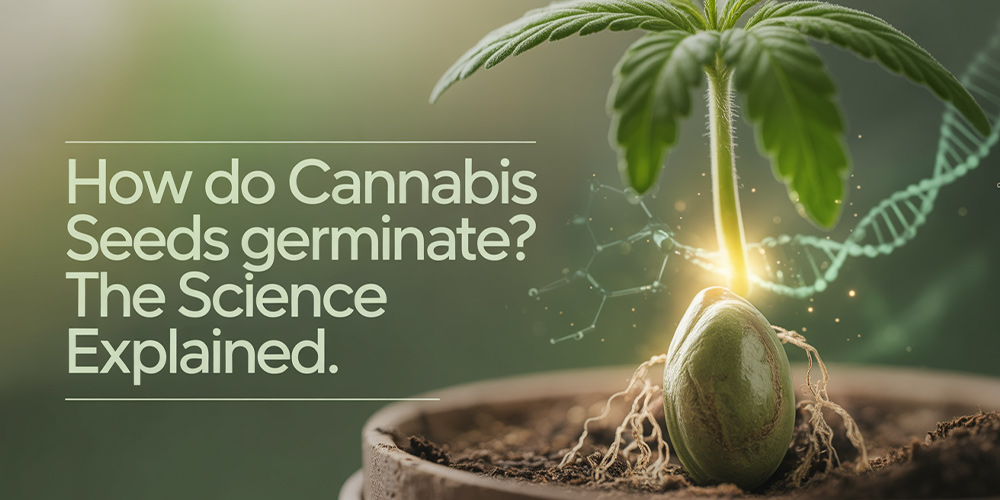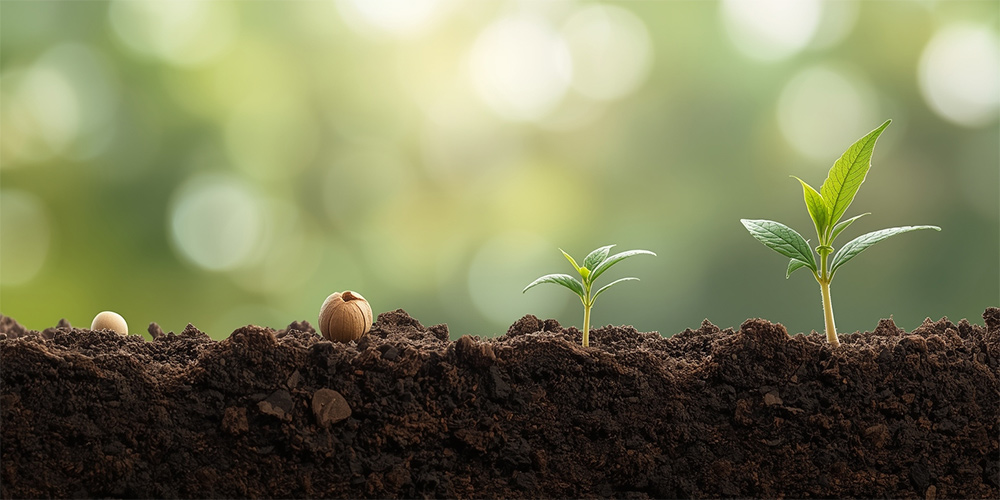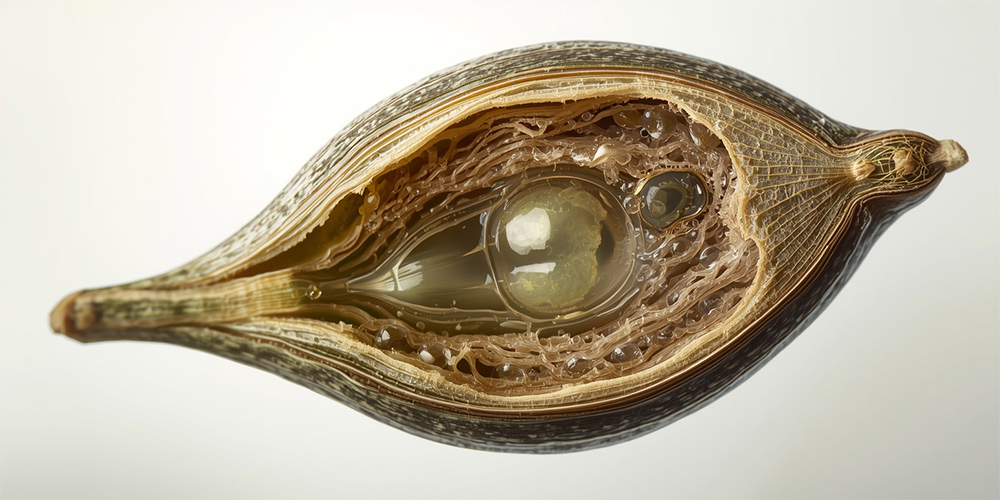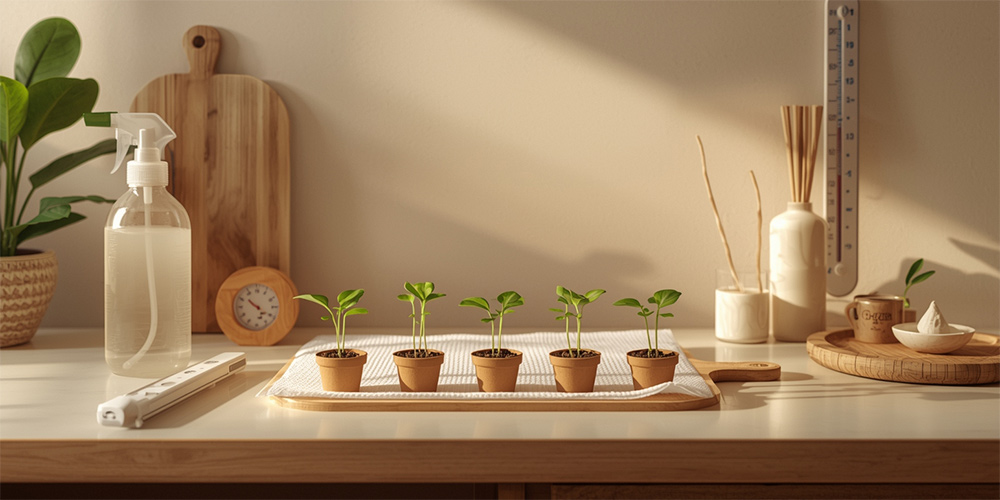
Home » How Do Cannabis Seeds Germinate? The Science Explained
How Do Cannabis Seeds Germinate? The Science Explained
Every towering cannabis plant begins as a small, dormant seed holding the blueprint for life. Germination is the process that awakens this potential, transforming a dry seed into a growing seedling. For growers and researchers, understanding how and why germination occurs isn’t just fascinating — it’s essential for improving success rates and ensuring healthy plants.
In this article, we break down the science of cannabis seed germination, explaining each biological stage, the hormones that control it, and the environmental factors that determine success. Drawing on recent research (2023–2025), including findings from the University of Western Australia, University of Naples, and University of Warsaw, we’ll explore how moisture, temperature, and light activate life inside a seed — and how Australian conditions shape that process.
(Educational note: Cannabis cultivation is regulated in Australia. Information here applies to research and licensed hemp production.)
Understanding Cannabis Seed Germination
What Is Germination?
Germination is the process by which a seed resumes growth after dormancy, producing the first root (radicle) and shoot that establish a new plant. In cannabis, germination signals the transition from a resting embryo to active metabolism and cell division.
Unlike many other species, cannabis seeds germinate rapidly under the right conditions — usually within 24 to 72 hours — because their seed coat allows efficient water absorption once moisture and warmth reach critical levels.

The Stages of Germination (Step-by-Step Science)
- Imbibition: The seed absorbs water, swelling and rehydrating cellular membranes.
- Metabolic Activation: Enzymes resume activity, respiration increases, and stored energy reserves (starches, proteins, and lipids) begin to mobilize.
- Radicle Emergence: The embryonic root breaks through the seed coat, anchoring the young plant and facilitating water absorption.
- Seedling Establishment: The shoot (plumule) grows upward, preparing for photosynthesis.
Want to put this science into practice? Read our guide on How to Germinate Cannabis Seeds: Step-by-Step for proven techniques, ideal conditions, and expert grower tips tailored to Australian environments.
Key takeaway: Germination begins invisibly. The biochemical switch is flipped long before the root tip appears.
The Inner Workings — Science Behind the Process
Hormonal Regulation (ABA vs GA)
Two plant hormones control whether a cannabis seed remains dormant or begins to sprout:
- Abscisic acid (ABA): Maintains dormancy and inhibits premature germination.
- Gibberellic acid (GA): Triggers enzyme synthesis and embryo growth.
A 2024 study from the University of Naples showed that reducing ABA levels while increasing GA activity accelerates germination by up to 25%. Similarly, research by the University of Western Australia (2023) found that GA₃ treatments shortened germination time in hemp cultivars, confirming its pivotal role.

Energy Mobilization and Enzymes
Once rehydrated, the seed’s mitochondria reactivate, and enzymes such as amylase, protease, and lipase convert stored nutrients into usable energy. Microscopic analysis by the University of Warsaw (2023) revealed rapid lipid body breakdown within 12 hours of water absorption — evidence that energy metabolism begins almost instantly after imbibition.
Oxygen, Light, and Temperature Interactions
Cannabis seeds require oxygen for respiration; waterlogged conditions can suffocate the embryo. While light is not essential for initial germination, low-intensity red light can enhance enzyme activation.
Optimal environmental conditions for cannabis seed germination (Australia):
| Factor | Ideal Range | Notes |
| Temperature | 22–26 °C | Slight day-night fluctuation improves uniformity |
| Relative humidity | 70–90 % | Maintain moist but not saturated medium |
| Oxygen | Good aeration | Avoid waterlogging |
| Light | Dim or indirect | Not essential but can aid uniformity |
| Duration | 24–72 hours | Depends on cultivar and seed age |
Factors That Affect Germination Success
Genetic and Environmental Variability
Not all cannabis seeds behave identically. Landrace varieties from warmer regions may tolerate higher temperatures, while industrial hemp cultivars used in Tasmania germinate best in cooler, stable conditions.
A 2024 University of Guelph study found up to 30% variation in germination rates among hemp genotypes, emphasizing the need for location-specific optimization — especially relevant for Australia’s diverse climates.
Dormancy and Viability
Some seeds remain dormant even under ideal conditions. Dormancy often results from hard seed coats or residual ABA levels. Viability can be tested using:
- Float test: Non-viable seeds often remain afloat.
- Tetrazolium staining: Detects living tissue activity.
- Germination percentage test: Measures actual emergence rates.
Storage also affects viability. In Australia’s humid regions, sealed containers kept below 10 °C with silica gel maintain germination potential for over a year.
Enhancing Germination — Evidence-Based Techniques
Seed Priming Methods
Recent advances show that pre-treatments can significantly boost germination speed and uniformity:
| Priming Method | Mechanism | Research Insight |
| Hydrogen peroxide (1 %) | Reduces microbial load and triggers oxidative signaling | Czech Academy of Sciences (2021) — 90 % contamination reduction |
| Osmopriming (PEG solution) | Improves water potential and enzyme activation | University of Guelph (2024) — 20–30 % faster emergence |
| Hormonal priming (GA₃) | Balances ABA / GA ratio | University of Western Australia (2023) — Enhanced vigor |
Scarification and Seed Coat Management

While cannabis seeds rarely need mechanical scarification, gently roughening the seed coat can speed water uptake in older or overly dry seeds. Chemical scarification (e.g., acid treatments) is unnecessary and can damage embryos.
Avoiding Common Germination Failures
- Over-soaking: More than 48 hours can deprive seeds of oxygen.
- Poor hygiene: Contaminated water introduces fungi.
- Extreme temperatures: Below 18 °C slows metabolism; above 30 °C causes protein denaturation.
- Low oxygen: Waterlogged mediums suffocate embryos.
Even experienced growers sometimes face setbacks. To minimize issues and improve success rates, check our expert breakdown of Common Cannabis Seed Germination Mistakes to Avoid — complete with solutions based on current research.
Tip: If germination halts, improve aeration before changing moisture levels.
Germination Research in Australia
Australian institutions such as Queensland Agriculture & Fisheries (2024) and the Australian Hemp Council (2023) have examined how industrial hemp seeds respond to local temperature and humidity. Results show that autumn sowing in temperate zones (VIC, SA) gives the highest germination rates, while late-summer planting in Queensland benefits from higher soil warmth.
These studies also highlight that locally bred hemp varieties outperform imported cultivars under Australian light and moisture regimes — evidence that climate-adapted genetics matter as much as technique.
(Legal note: Germination is only permitted for licensed industrial hemp and research activities in Australia.)
Practical Summary — From Seed to Sprout
| Stage | Key Process | Best Practice |
| Imbibition | Water absorption | Keep medium evenly moist (not soaked) |
| Activation | Enzyme restart | Maintain 22–26 °C |
| Radicle emergence | Root protrusion | Ensure oxygen exchange |
| Seedling establishment | Shoot development | Gradual light exposure |
Key takeaway: Successful germination is a harmony between internal biochemistry and external environment. Balance both for consistent results.
Conclusion
The germination of cannabis seeds is both a scientific marvel and a delicate balance of hormones, energy, and environment. Understanding how water, oxygen, and temperature awaken life within a seed allows growers and researchers to maximize success while remaining compliant with Australian laws.
By applying recent scientific insights — from hormonal control to advanced priming — the humble cannabis seed becomes a model of biological precision and adaptability.
FAQ
1. How long does cannabis seed germination take?
Usually between 24 and 72 hours, depending on cultivar and temperature.
2. What temperature works best for cannabis seed germination?
Ideal range is 22–26 °C with mild day–night variation.
3. Do cannabis seeds need light or darkness to germinate?
They germinate best in darkness or low light, but light is not harmful.


One Response